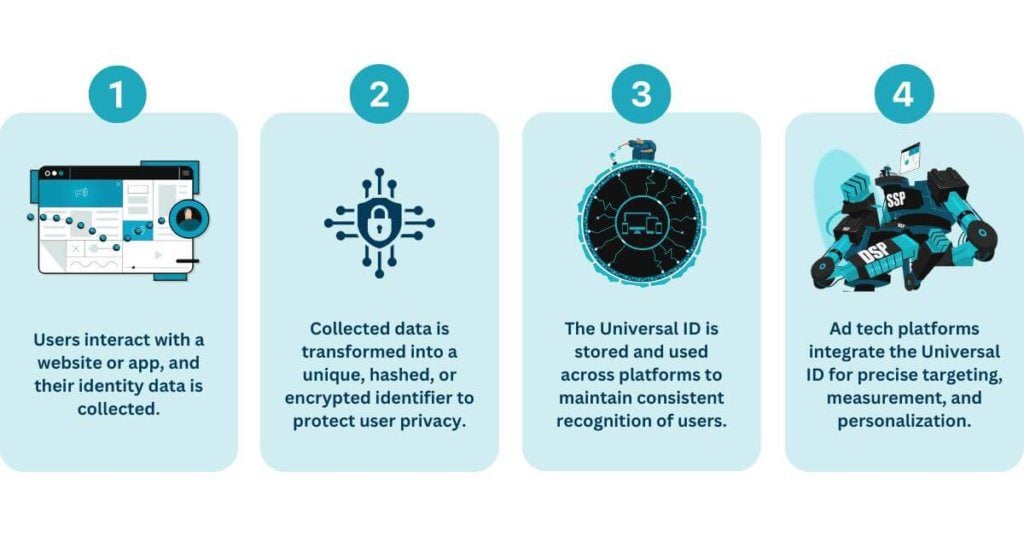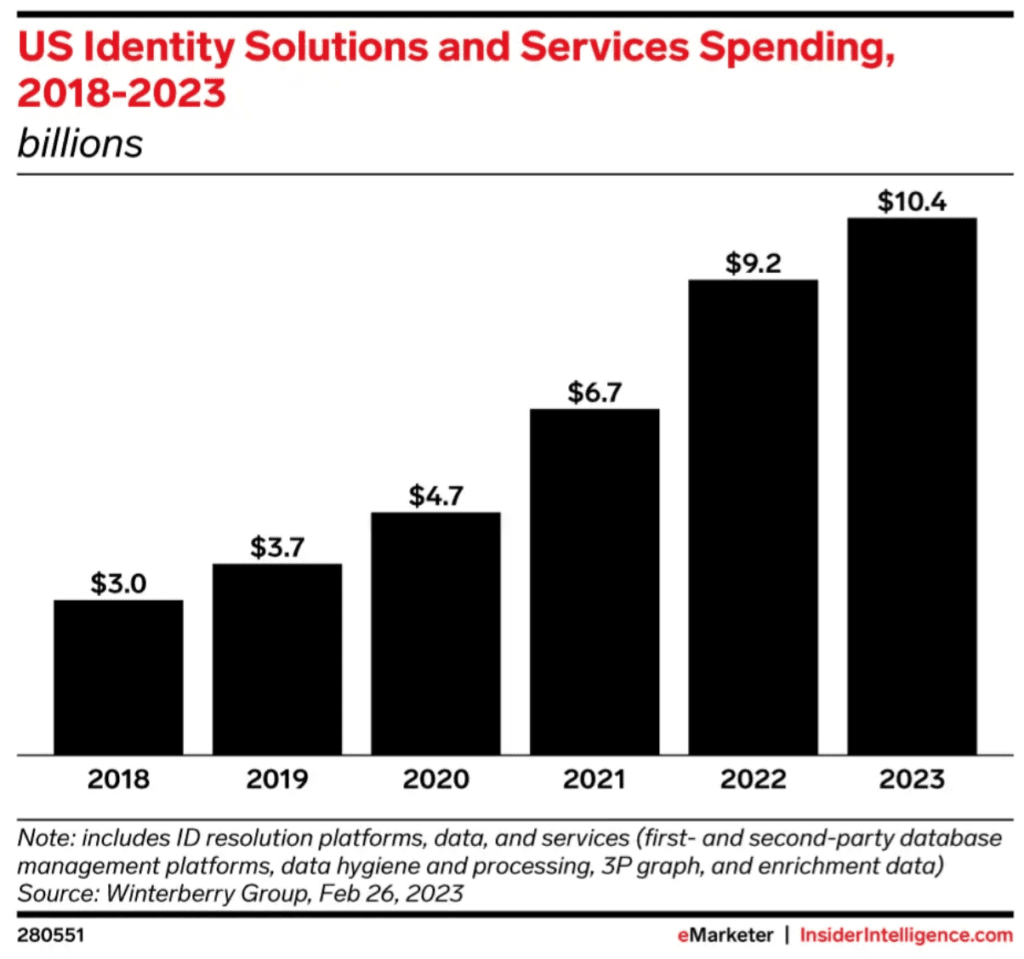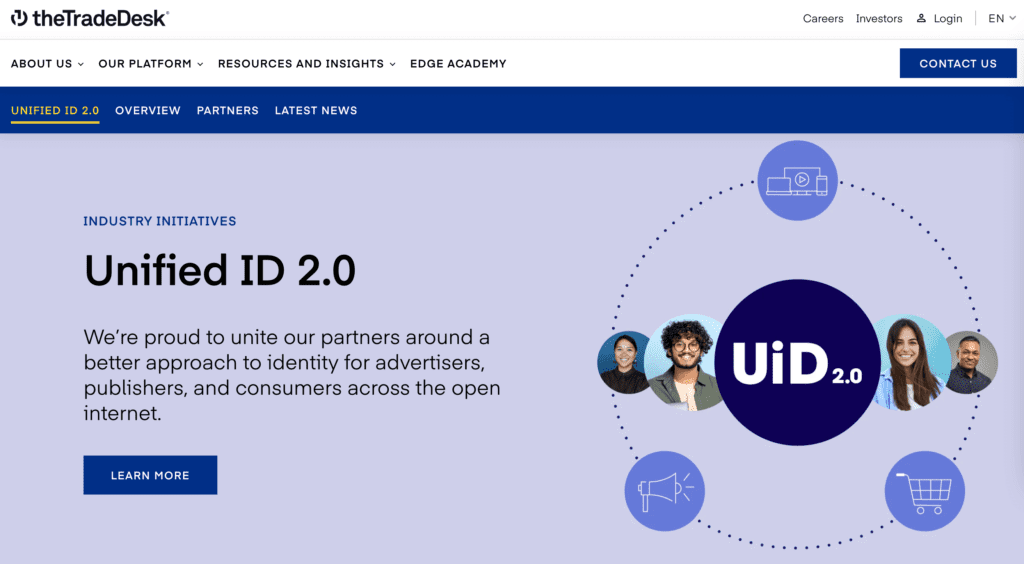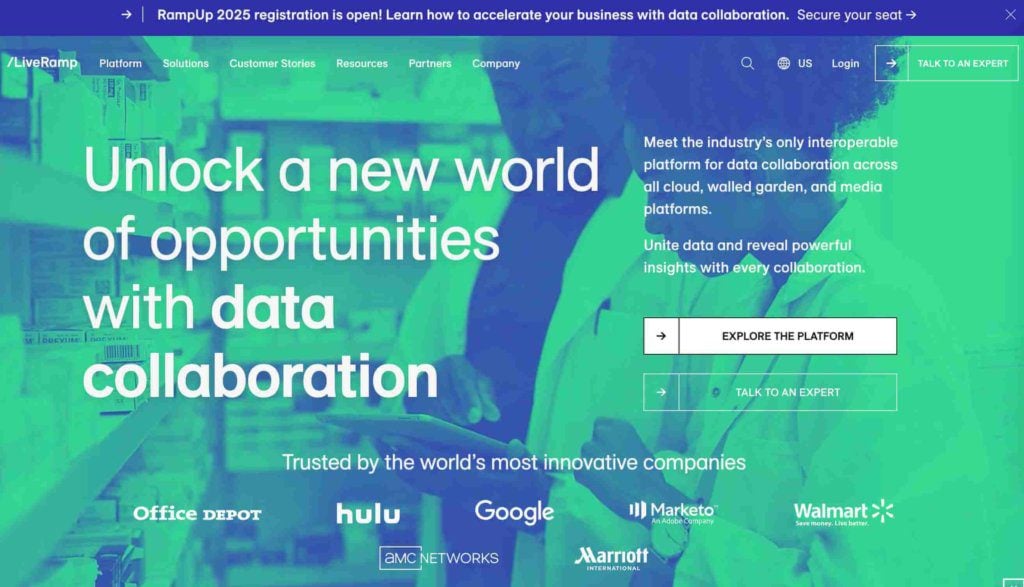What is Universal ID?
Universal ID is a promising alternative to third-party cookies that addresses privacy concerns and offers more robust and efficient ways to track and target users across platforms.
The programmatic advertising industry is transforming rapidly due to tightening privacy regulations and evolving browser policies. As third-party cookies face deprecation, publishers, advertisers, and ad tech vendors are racing to find new ways to deliver effective, privacy-compliant ad experiences.
In response, major ad tech players like The Trade Desk and LiveRamp and consortiums such as IAB and Prebid have stepped up to develop Universal ID solutions. These solutions aim to replace traditional cookie syncing with more streamlined, privacy-first user identification methods.
In this article, we’ll explore the fundamentals and advantages of Universal IDs, the key players driving their adoption, and why they matter.

What is Universal ID?
A Universal ID is a unique identifier assigned to a user that enables consistent recognition across various digital platforms and devices. Unlike traditional third-party cookies, which are domain-specific and often blocked by browsers, Universal IDs provide a standardized method for tracking user interactions in a privacy-compliant manner.
What problems does it solve?
Universal IDs enable advertisers and publishers to recognize users consistently across websites, apps, and devices, creating a cohesive strategy and personalized experience. They enhance privacy compliance by using deterministic data like hashed email addresses, giving users more control over their data and reducing dependency on third-party cookies.
Universal IDs also minimize data discrepancies, resulting in more accurate targeting and measurement, and simplify the ad-buying process by eliminating complex cookie syncing.
How Does Universal ID Work?
Universal ID creates a single, persistent identifier for a user that can be recognized across different platforms, devices, and channels. Unlike third-party cookies tied to specific domains and often blocked by modern browsers, Universal IDs are more robust and privacy-compliant.
Here are the 4 main steps that show how Universal ID typically works:
- When users interact with a website or app, their identity data is collected through deterministic (like email logins) or probabilistic signals (such as device characteristics or IP addresses). Some systems may request explicit user consent to collect and use this data.
- The collected data is used to generate a unique identifier for the user. This identifier can be hashed or encrypted to protect user privacy and security. For example, a hashed email may be the basis for creating the Universal ID.
- The Universal ID is stored and used by publishers, advertisers, and platforms to recognize the same user across multiple sessions, devices, and channels. This enables consistent and personalized experiences while maintaining privacy compliance.
- Platforms such as DSPs, SSPs, and DMPs integrate the Universal ID into their systems. This allows advertisers to target users accurately, measure campaign effectiveness, limit ad frequency, and enhance ad personalization while reducing the need for complex cookie syncing.

Key considerations for implementation
Before implementing an identity solution, marketers should assess gaps in their data and determine which solutions align with their needs.
Securing organizational support from leadership and maintaining a continuous “test-and-learn” approach is essential to find what works best. It’s equally important to rethink measurement strategies and prioritize user privacy when adopting any identity solution.
Given that many identity solutions are still evolving, marketers need to allow for trial and error.
Additionally, these solutions can be expensive and require specialized proper implementation skills. The Winterberry Group projected that in the U.S. alone, $10.4 billion would be spent in 2023 on data, data services, and infrastructure. This shows how Universal IDs can shape the future of privacy-compliant, effective digital marketing, but with challenges regarding investment, expertise, and evolving strategies.

Source: eMarketer
Data Sources
First-party data
First-party data is the information a company collects directly from its users, typically through subscriptions, surveys, website interactions, and feedback forms. This data is owned by the company collecting it and offers deep insights into user behavior and preferences.
First-party and offline data can serve as inputs for creating a Universal ID, but they are not equivalent. While publishers can generate their site-specific user IDs to recognize users within their own ecosystem, these IDs are not universal and lack the cross-platform capabilities of a Universal ID.
Deterministic data
Deterministic data, such as names, email addresses, or login credentials, is known and provided directly by the user. Deterministic solutions use this data to create precise user matches and target specific audiences with high accuracy. However, much of this data resides in “walled gardens,” such as social media logins, making it challenging to scale beyond those platforms.
Probabilistic data
Probabilistic data relies on temporary, changing information, such as IP addresses, device characteristics, or browsing behaviors. This data is analyzed to infer user identities or predict behaviors, making it useful for reaching broader audiences and scaling campaigns. While less precise than deterministic data, it helps marketers identify patterns and target users across different touchpoints.
Note: The most effective ID solutions often combine deterministic and probabilistic data to capture the full customer journey. Deterministic matching links data using common identifiers like email addresses, while probabilistic matching uses algorithms and multiple data sources to infer identities across devices and channels.
Types of Universal IDs
As universal IDs continue to evolve, three primary types have emerged. The main distinction lies in where each solution gathers and utilizes identity data, impacting flexibility and long-term viability. Let’s take a closer look at them.
First-Party Data-Based ID Solutions
First-party data-based solutions focus on user information collected directly by publishers, advertisers, or brands from their customers. LiveRamp’s Identity Link, introduced in 2016, was one of the pioneers in this category.
It uses data from various sources, including first-party CRM data, offline data sources, and even third-party cookies (while still in use). This approach allows advertisers and publishers to maintain strong connections with their users by using data they control, ensuring greater privacy compliance and more accurate targeting.
Proprietary ID Solutions
Specific companies develop and control proprietary solutions, offering unique user identification and data handling methods. The Trade Desk’s Unified ID is a notable example of this category.
It aims to streamline cookie-syncing across platforms, reducing data loss and improving match rates. Unified ID aggregates cookie-based information to create a more standardized approach to user identification.
However, its reliance on cookies means it faces potential limitations as browsers move to restrict or eliminate cookie tracking. For companies exploring alternatives to traditional methods, proprietary solutions like this provide a starting point.
Industry ID Solutions
Industry-wide ID solutions are typically developed by independent entities and designed for broad adoption across the advertising ecosystem. An example is DigiTrust ID, which aims to establish a universal, standardized identity service that is not tied to a specific company.
DigiTrust uses a simplified cookie-syncing process, creating a consistent identifier across platforms. However, like other cookie-based solutions, its utility may diminish as cookies are phased out by major browsers, requiring further innovation to maintain relevance.
Single vs. Multiple IDs
So, what happens if you use the single ID approach?
In this model, a user is assigned one consistent identifier that can be recognized and used across various platforms, devices, and channels. The single ID simplifies user recognition and tracking, reducing data management’s complexity and improving cross-platform targeting and personalization accuracy.
It provides a unified view of user interactions, enhancing the consistency of campaigns and ensuring better user experiences. However, it may increase reliance on a single provider, posing privacy and control challenges.
Now, let us look at the multiple IDs approach.
This involves using different identifiers for the same user across various platforms, devices, or data sources. While it may offer flexibility, it also complicates managing user data.
Multiple IDs can lead to fragmented user profiles, making it harder to achieve consistent targeting and personalization. However, it can provide more control over data privacy and security since it minimizes reliance on a single tracking system and allows for more granular tracking strategies.
Wrapping this up–a single ID provides a streamlined, consistent view of users, while multiple IDs offer flexibility but may require more sophisticated data integration and management.
Thus, the choice between single and multiple IDs depends on the organization’s goals, privacy concerns, and the complexity of its marketing ecosystem.
Universal ID Solutions
While identity resolution is not a new concept, changes in digital advertising–such as Apple’s AppTrackingTransparency framework and new privacy regulations–have accelerated the shift away from traditional identifiers like cookies. This change has prompted advertisers to seek alternative identity solutions that align with evolving privacy standards.
Current identity solutions include tools and privacy-preserving mechanisms to balance effective user targeting with data privacy compliance.
Trade Desk’s Unified ID 2.0
The Trade Desk, one of the leading DSPs, offers a powerful proprietary identifier called Unified ID 2.0. Designed to benefit the entire advertising community, this solution aims to significantly improve match rates while boosting advertisers’ ROI and increasing programmatic revenue for publishers.
When users provide their email addresses to access sites integrated with Unified ID 2.0, the system creates an encrypted ID token tied to their email. This token is securely shared across advertisers’ bidding networks for targeted marketing, maintaining privacy and user consent. By encrypting the email and requiring user approval before any data is used, Unified ID 2.0 aligns with stringent data privacy regulations and offers a solid alternative to third-party cookies.
The Trade Desk makes Unified ID 2.0 freely available to advertisers, agencies, and DSPs. Publishers can also integrate the solution. This wide availability encourages industry-wide adoption and ensures a consistent user identification system.

How to Implement Unified ID 2.0?
- For publishers partnered with SSPs. Contact your SSPs to see if you are included in the Unified ID 2.0 solution. If not, ask for guidance on how to update your integration and become a participant in the ecosystem.
- For publishers using Prebid.js. If you have integrated Prebid.js independently, review Prebid’s User ID module and ensure Unified ID 2.0 is added to the wrapper modules.
- For managed header bidding solutions. If you work with a managed header bidding provider, ask if they support the Unified ID module. If they do not, encourage them to adopt it, as this can lead to higher match and bid rates, improving your programmatic outcomes.
Potential drawbacks
However, Unified ID 2.0 has its drawbacks.
One primary concern is that it consolidates significant power in the hands of a single industry player–The Trade Desk. If Unified ID 2.0 becomes the dominant or sole solution, the entire advertising ecosystem may depend on The Trade Desk for user identification across the open web.
Unified ID 2.0 also faces challenges from evolving browser restrictions, such as Intelligent Tracking Prevention (ITP) from Apple and anticipated changes in Chrome, which may limit its effectiveness.
LiveRamp’s RampID (ex. IdentityLink)
In 2016, LiveRamp launched its identity solution, initially known as IdentityLink and now rebranded as RampID. RampID assigns an anonymous identifier to users, linking their activity across various devices and platforms.
It enables advertisers to control the frequency of their ads for specific users, enhancing the user experience and minimizing ad fatigue. Rather than relying on separate cookie syncing, SSPs and DSPs can integrate RampID directly into their bid streams, improving match rates and more efficient targeting.
The identifier leverages deterministic matching, combining data from both online and offline sources to provide accurate user identification. Doing so offers publishers and advertisers a comprehensive view of their audiences while respecting user privacy.
In short, RampID uses first-party and third-party data and is designed to function beyond the “cookie apocalypse” as cookies are phased out.

Publisher Common ID
Publisher Common ID empowers publishers to create and manage their universal IDs, offering enhanced control over their ad inventory and data.
By generating IDs for trusted advertising partners, publishers can serve as their own identity providers, integrating universal ID solutions within their websites. This approach helps maintain user data security and streamlines ad targeting while providing flexibility for publishers in managing their audiences.
Benefits of Universal ID
Enhanced privacy
Universal IDs provide a solution that does not rely on third-party cookies for user identification and tracking. By using deterministic data to create unique matches, publishers can continue to track and recognize users even as major browsers block third-party cookies.
This makes universal IDs more resilient to evolving browser restrictions and privacy updates.
These IDs prioritize user privacy by leveraging deterministic data sources, such as hashed email addresses, often requiring user consent. This aligns with strict privacy regulations and offers users greater control over their data.
Better targeting and cross-device tracking
Universal IDs enable advertisers and publishers to create more accurate and personalized marketing campaigns by providing a consistent user identifier. Unlike traditional cookies, universal IDs offer seamless functionality across multiple devices, such as desktops, tablets, and mobile phones.
Users who access a platform from different devices are identified as a single, unified profile rather than duplicated. This cross-device consistency enhances targeting accuracy, delivering a cohesive experience for publishers and marketers.
Improved revenue potential
Enhanced user match rates translate to more valuable inventory for publishers. When advertisers are confident in the accuracy of user identities, they are willing to place higher bids for impressions.
Universal ID-based systems leverage deterministic data for precise targeting, outperforming older probabilistic models. Many businesses have reported substantial ad performance and ROI increases after adopting universal ID solutions.
Data accuracy
Universal IDs create a unified, consistent view of users, reducing data discrepancies often arising with fragmented identifiers or cookie-based tracking. They offer nearly 100% match rates, minimizing user duplication risk and improving data samples’ accuracy.
This ensures better alignment between user interests and displayed ads. Marketers can further enhance data collection by offering value-based exchanges, such as loyalty programs, encouraging users to provide their identity information voluntarily. This data is then tied to a Universal ID, which recognizes users across platforms, providing more reliable and authenticated targeting.
Better UX and viewability
Traditional cookie-based systems often slow down websites due to third-party cookie-syncing processes. Universal ID solutions eliminate this need, enhancing page speed and user experience. Additionally, universal IDs focus on deterministic data for targeting, reducing irrelevant ad displays. This ensures users see more relevant ads, boosting campaign effectiveness and minimizing user frustration.
Research has shown that consumers are more receptive to ads aligned with their interests and are often annoyed by irrelevant content, emphasizing the importance of precise targeting for a better UX.
Challenges and Limitations
The Universal ID market is still in its early stages. While starting a UID company is relatively simple, standing out and achieving meaningful differentiation is much harder. To succeed, vendors must establish strong relationships with publishers to ensure they adopt and use their specific UID schemes. This must be followed by driving adoption among adtech providers to create widespread mindshare and industry acceptance.
The challenge lies in the lack of standardization around UIDs. While this may not be a critical issue at the moment, the abundance of UID solutions leads to interoperability challenges. The fragmented market makes it difficult for different systems to work together smoothly, complicating user tracking and targeting efforts.
For digital marketers, it is still too early to place definitive bets on any single UID solution.
Adoption barriers
Despite the potential benefits, widespread adoption of Universal IDs faces significant hurdles. Many organizations may lack the technical expertise or resources to implement these systems effectively. Additionally, some publishers and advertisers may hesitate to adopt new technology due to compatibility issues with existing systems or concerns about scalability and long-term viability.
Unlike cookies, which are automatically placed in a user’s browser upon visiting a site, Universal IDs often require an active consumer action, such as sharing an email or logging in.
Cookies can track users across multiple domains, but Universal IDs are often confined to a single domain, reducing their reach and flexibility. This makes it essential for marketers to adopt a broader approach rather than relying solely on UIDs.
Establishing user identity through Universal IDs typically requires authentication, with email being the most common method in the U.S. In regions such as Asia, mobile phone numbers are more commonly used for authentication.
This regional variation highlights the complexity of creating a scalable, global solution for user identification.
Industry fragmentation
Universal IDs lack standardization across the industry, creating a fragmented landscape of competing solutions from vendors such as LiveRamp, The Trade Desk, and ID5. Each provider offers its approach to user identification, making it challenging for the industry to achieve a unified, scalable solution.
For example, the Trade Desk’s Unified ID generates UIDs using customer-provided email addresses, typically collected through site logins or access to additional content.
Other companies, such as LiveRamp, Tapad, Epsilon, and Flashtalking, generate UIDs using email addresses and a mix of deterministic and probabilistic data from various sources. While this approach broadens the data pool for user identification, it also increases complexity due to the different methods used by each vendor.
Proprietary solutions alone will struggle to achieve broad scalability, as each website needs to implement a compatible solution. The likelihood of sites adopting proprietary UIDs from numerous vendors is low, further fragmenting the ecosystem.
Standardization is crucial for achieving industry-wide adoption, driving investment, and creating stability. The lack of a unified standard has led to a scenario where only a few prominent companies with significant industry presence can maintain a universal ID posture.
The Future of Universal ID
The adoption of UIDs is expected to grow as publishers, advertisers, and ad tech platforms seek alternatives to third-party cookies. However, the current landscape is fragmented. This fragmentation poses challenges for interoperability and scalability. Industry experts anticipate a consolidation towards standardized UID solutions to enhance efficiency and cross-platform compatibility.
UIDs are designed to align with stringent privacy regulations by utilizing deterministic data sources, such as hashed email addresses, and obtaining explicit user consent. As privacy regulations evolve, UID frameworks must adapt to maintain compliance and user trust.
Additionally, developing privacy-preserving technologies, such as differential privacy and federated learning, may further bolster the capabilities of UID solutions while safeguarding user data.

Conclusion
As privacy concerns around third-party cookies grow, their use is increasingly considered invasive. Universal IDs come as a compelling solution by creating a shared user identity throughout the digital advertising supply chain.
With their emphasis on privacy and seamless integration, Universal IDs pave the way for personalized, contextually relevant web experiences while maintaining user trust. This allows publishers, advertisers, and users to collaborate in building a more secure and privacy-conscious digital ecosystem.
By adopting Universal IDs, publishers can continue to target their audiences effectively, deliver personalized content, and optimize ad campaigns without relying on cookies. This opens doors to better user experiences, enhanced data privacy, and more effective advertising strategies in a cookie-less future.


